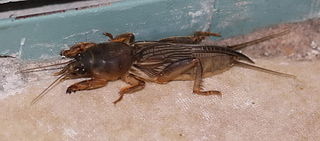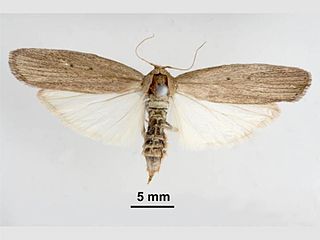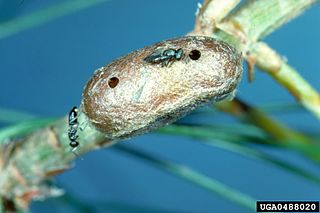
Moths are a paraphyletic group of insects that includes all members of the order Lepidoptera that are not butterflies, with moths making up the vast majority of the order. There are thought to be approximately 160,000 species of moth, many of which have yet to be described. Most species of moth are nocturnal, but there are also crepuscular and diurnal species.

The Tachinidae are a large and variable family of true flies within the insect order Diptera, with more than 8,200 known species and many more to be discovered. Over 1300 species have been described in North America alone. Insects in this family commonly are called tachinid flies or simply tachinids. As far as is known, they all are protelean parasitoids, or occasionally parasites, of arthropods, usually other insects. The family is known from many habitats in all zoogeographical regions and is especially diverse in South America.

Trichogramma is a genus of minute polyphagous wasps that are endoparasitoids of insect eggs. Trichogramma is one of around 80 genera from the family Trichogrammatidae, with over 200 species worldwide.

The scarlet lily beetle, red lily beetle, or lily leaf beetle, is a leaf beetle that eats the leaves, stem, buds, and flowers, of lilies, fritillaries and other members of the family Liliaceae. It lays its eggs most often on Lilium and Fritillaria species. In the absence of Lilium and Fritillaria species, there are fewer eggs laid and the survival rate of eggs and larvae is reduced. It is now a pest in most temperate climates where lilies are cultivated.

Hyalophora cecropia, the cecropia moth, is North America's largest native moth. It is a member of the family Saturniidae, or giant silk moths. Females have been documented with a wingspan of five to seven inches (160 mm) or more. These moths can be found all across North America as far west as Washington and north into the majority of Canadian provinces. Cecropia moth larvae are most commonly found on maple trees, but they have also been found on cherry and birch trees among many others. The species was first described by Carl Linnaeus in his 1758 10th edition of Systema Naturae.

A planthopper is any insect in the infraorder Fulgoromorpha, in the suborder Auchenorrhyncha, and exceeding 12,500 described species worldwide. The name comes from their remarkable resemblance to leaves and other plants of their environment and from the fact that they often "hop" for quick transportation in a similar way to that of grasshoppers. However, planthoppers generally walk very slowly. Distributed worldwide, all members of this group are plant-feeders, though surprisingly few are considered pests. The infraorder contains only a single superfamily, Fulgoroidea. Fulgoroids are most reliably distinguished from the other Auchenorrhyncha by two features; the bifurcate ("Y"-shaped) anal vein in the forewing, and the thickened, three-segmented antennae, with a generally round or egg-shaped second segment (pedicel) that bears a fine filamentous arista.

Eurybrachidae is a small family of planthoppers with species occurring in parts of Asia, Australia and Africa. They are remarkable for the sophistication of their automimicry.

Uraba lugens, the gum-leaf skeletoniser, is a moth of the family Nolidae. It is found in Australia and New Zealand. The larvae are a serious pest of Eucalyptus species and their close relatives. The wingspan is 25–30 mm. In Australia there are about one or two generations per year.

Gryllotalpa orientalis is a species of mole cricket in the family Gryllotalpidae, commonly known as the oriental mole cricket. It is found in much of Asia and Australasia. At one time, this species was misidentified as G. africana and thought to have a widespread distribution in both Africa and Asia, but in the 1980s, G. orientalis was recognised as a separate species. It is a polyphagous pest, damaging crops by gnawing their roots.

Eldana is a genus of moths of the family Pyralidae containing only one species, the African sugar-cane borer, which is commonly found in Equatorial Guinea, Ghana, Mozambique, Sierra Leone and South Africa. Adults have pale brown forewings with two small spots in the centre and light brown hindwings, and they have a wingspan of 35mm. This species is particularly relevant to humans because the larvae are a pest of the Saccharum species as well as several grain crops such as sorghum and maize. Other recorded host plants are cassava, rice and Cyperus species. When attacking these crops, E. saccharina bores into the stems of their host plant, causing severe damage to the crop. This behavior is the origin of the E. saccharrina's common name, the African sugar-cane borer. The African sugar-cane borer is a resilient pest, as it can survive crop burnings. Other methods such as intercropping and parasitic wasps have been employed to prevent further damage to crops.

Scirpophaga incertulas, the yellow stem borer or rice yellow stem borer, is a species of moth of the family Crambidae. It was described by Francis Walker in 1863. It is found in Afghanistan, Nepal, north-eastern India, Sri Lanka, Bangladesh, Myanmar, Vietnam, Thailand, Malaysia, Singapore, Sumatra, Java, Borneo, Sumba, Sulawesi, the Philippines, Taiwan, China and Japan.

Planococcus citri, commonly known as the citrus mealybug, is a species of mealybugs native to Asia. It has been introduced to the rest of the world, including Europe, the Americas, and Oceania, as an agricultural pest. It is associated with citrus, but it attacks a wide range of crop plants, ornamental plants, and wild flora.
Chilo infuscatellus, the yellow top borer or sugarcane shoot borer, is a moth in the family Crambidae. It was described by the Dutch entomologist Samuel Constantinus Snellen van Vollenhoven in 1890. It is found in India, Myanmar, Tajikistan, Afghanistan, Korea, Taiwan, Malaysia, the Philippines and on Java and Timor.
Bissetia steniellus is a moth in the family Crambidae. It was first described by the British entomologist George Hampson in 1899. It is found in India and Vietnam where it is commonly known as the Gurdaspur borer because the larvae bore their way into and feed on the stems of sugarcane.
Scirpophaga excerptalis, the white top borer or sugarcane top borer, is a moth in the family Crambidae. It was described by Francis Walker in 1863. It is found in southern Asia from the Indian Subcontinent in the west to southern China in the east, south to New Guinea, possibly Australia and the Solomon Islands.

Tamarixia radiata, the Asian citrus cyllid parasitoid, is an hymenopteran wasp from the family Eulophidae which was discovered in the 1920s in the area of northwestern India (Punjab), now Pakistan. It is a parasitoid of the Asian citrus psyllid, an economically important pest of citrus crops around the world and a vector for Citrus greening disease.

Neoscapteriscus vicinus, the tawny mole cricket, is a species of insect in the mole cricket family, Gryllotalpidae. Colombian insect taxonomist Oscar Cadena-Castañeda studied specimens of the genus that had been called Scapteriscus, and decided that it included two groups; a smaller group and a larger group that he named Neoscapteriscus in 2015. It is native to South America and also occurs in the Southern United States, where it arrived as a contaminant of ship's ballast around 1900. North American mole cricket taxonomists agreed with his decision and altered Orthoptera Species File Online accordingly.
Sturmiopsis inferens is a species of fly in the family Tachinidae. It is native to Asia and is a parasitoid of various moth species whose larvae feed inside the stems of sugarcane, rice and other large grasses, including the Gurdaspur borer and the sugarcane shoot borer.

Dahlbominus fuscipennis, the sawfly parasitic wasp, is a species of chalcid wasp from the family Eulophidae which parasitizes the European pine sawfly Neodiprion sertifer, among other hosts. It is the only species in the genus Dahlbominus.
Pyrilla perpusilla, commonly known as the sugarcane planthopper, is a planthopper in the family Lophopidae. It is native to Asia where it feeds on grasses and other plants and is a major pest of sugarcane.














